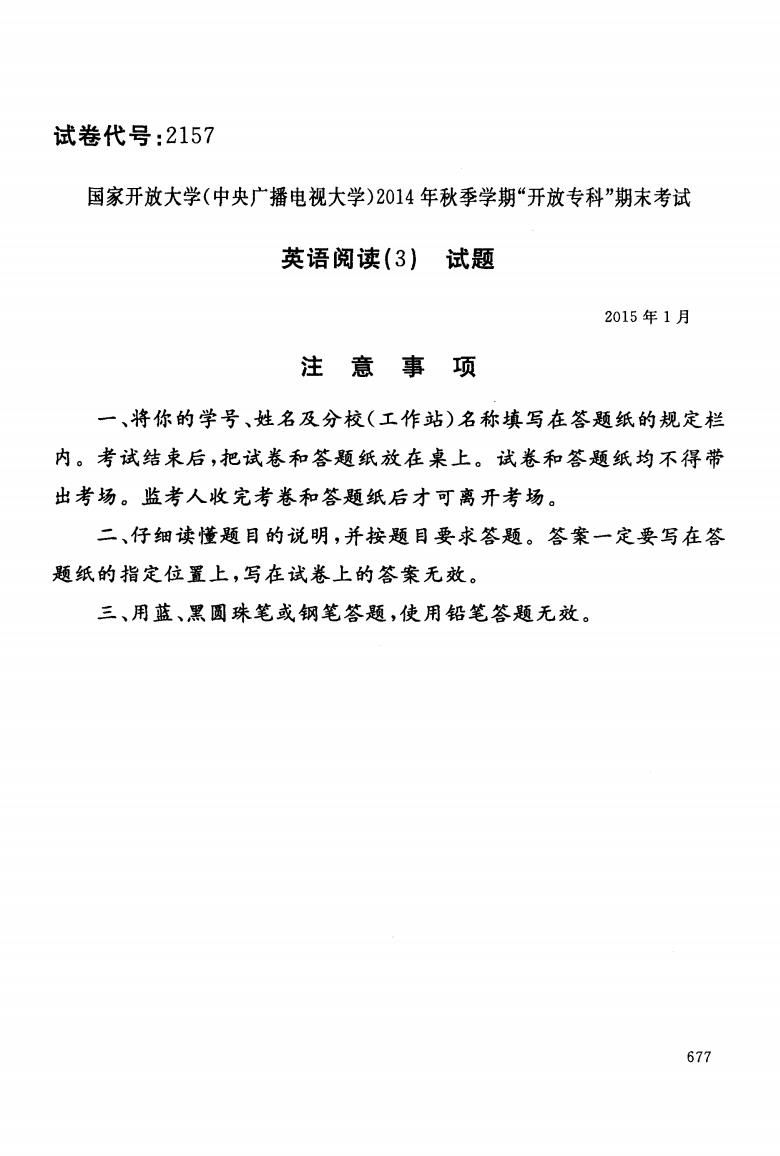
试卷代号:2157 国家开放大学(中央广播电视大学)2014年秋季学期“开放专科”期末考试 英语阅读(3)试题 2015年1月 注意事项 一、将你的学号、姓名及分校(工作站)名称填写在答题纸的规定栏 内。考试结束后,把试卷和答题纸放在桌上。试卷和答题纸均不得带 出考场。监考人收完考卷和答题纸后才可离开考场。 二、仔细读懂题目的说明,并按题目要求答题。答案一定要写在答 题纸的指定位置上,写在试卷上的答案无效。 三、用蓝、黑圆珠笔或钢笔答题,使用铅笔答题无效。 677
试卷代号 :2157 国家开放大学(中央广播电视大学 )2014 年秋季学期"开放专科"期末考试 英语阅读 (3) 试题 2015 注意事项 一、将你的学号、姓名及分校(工作站)名称填写在答题纸的规定栏 内。考试结束后,把试卷和答题纸放在桌上。试卷和答题纸均不得带 出考场。监考人收完考卷和答题纸后才可离开考场。 二、仔细读懂题目的说明,并按题目要求答题。答案一定要写在答 题纸的指定位置上,写在试卷上的答案无效。 三、用蓝、黑圆珠笔或钢笔答题,使用铅笔答题无效。 677
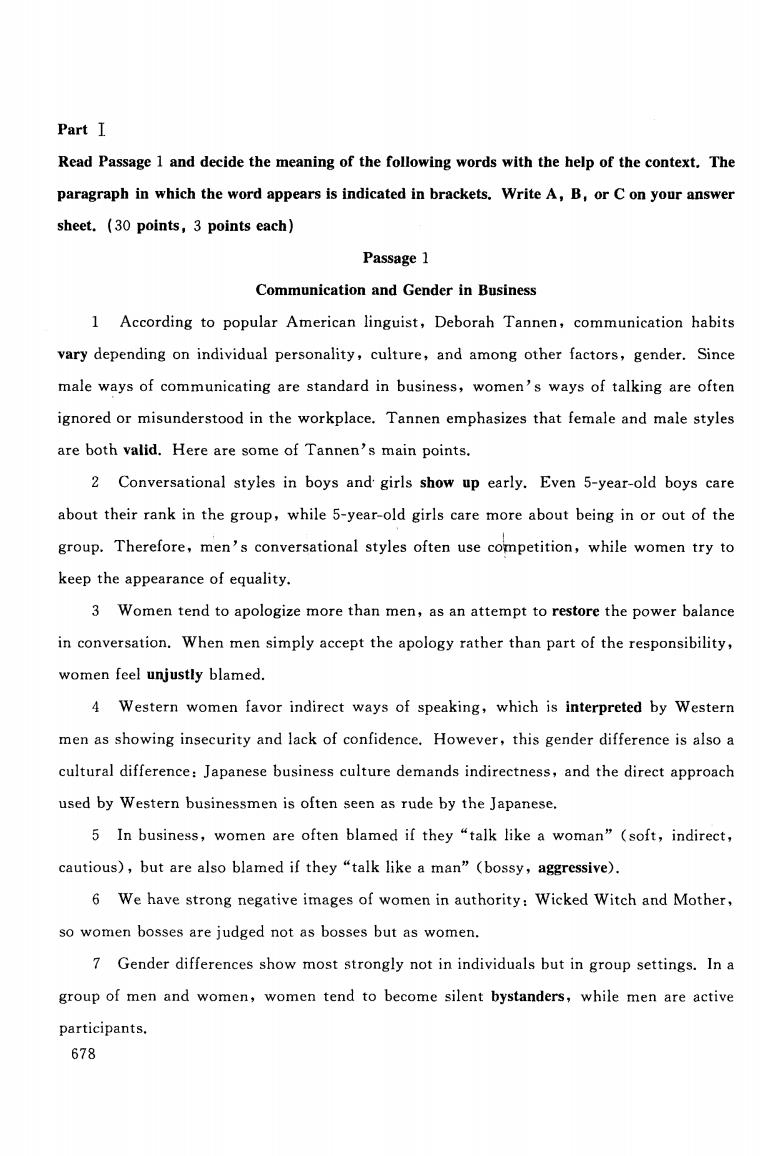
Part I Read Passage 1 and decide the meaning of the following words with the help of the context.The paragraph in which the word appears is indicated in brackets.Write A,B,or C on your answer sheet.(30 points,3 points each) Passage 1 Communication and Gender in Business 1 According to popular American linguist,Deborah Tannen,communication habits vary depending on individual personality,culture,and among other factors,gender.Since male ways of communicating are standard in business,women's ways of talking are often ignored or misunderstood in the workplace.Tannen emphasizes that female and male styles are both valid.Here are some of Tannen's main points. 2 Conversational styles in boys and girls show up early.Even 5-year-old boys care about their rank in the group,while 5-year-old girls care more about being in or out of the group.Therefore,men's conversational styles often use competition,while women try to keep the appearance of equality. 3 Women tend to apologize more than men,as an attempt to restore the power balance in conversation.When men simply accept the apology rather than part of the responsibility, women feel unjustly blamed. 4 Western women favor indirect ways of speaking,which is interpreted by Western men as showing insecurity and lack of confidence.However,this gender difference is also a cultural difference:Japanese business culture demands indirectness,and the direct approach used by Western businessmen is often seen as rude by the Japanese. 5 In business,women are often blamed if they "talk like a woman"(soft,indirect, cautious),but are also blamed if they "talk like a man"(bossy,aggressive). 6 We have strong negative images of women in authority:Wicked Witch and Mother, so women bosses are judged not as bosses but as women. 7 Gender differences show most strongly not in individuals but in group settings.In a group of men and women,women tend to become silent bystanders,while men are active participants. 678
Part 1 Read Passage 1 and decide the meaning of the following words with the help of the context. The paragraph in which the word appears is indicated in brackets. Write A. B. or C on your answer sheet. (30 points. 3 points each) Passage 1 Communication and Gender in Business 1 According to popular American linguist , Deborah Tannen , communication habits vary depending on individual personality , culture , and among other factors , gender. Since male ways of communicating are standard in business, women' s ways of talking are often ignored or misunderstood in the workplace. Tannen emphasizes that female and male styles are both valid. Here are some of Tannen' s main points. 2 Conversational styles in boys and- gir1 s show up ear1y. Even 5-year-old boys care about their rank in the group , while 5-year-old gir1s care more about being in or out of the group. Therefore , men' s conversational styles often use cobpetition , while women try to keep the appearance of equality. 3 Women tend to apologize more than men , as an attempt to restore the power balance in conversation. When men simply accept the apology rather than part of the responsibility , women feel unjustly blamed. 4 Western women favor indirect ways of speaking , which Ís interpreted by Western men as showing insecurity and lack of confidence. However, this gender difference is also a cultural difference: J apanese business culture demands indirectness, and the direct approach used by Western businessmen is often seen as rude by t he J apanese. 5 In business, women are often blamed if they "tall like a woman" (soft , indirect , cautious) , but are also blamed if they "talk like a man" (bOS8Y , aggressive). 6 We have strong negative images of women in authority: Wicked Witch and Mother, 80 women boss are judged not as bosses but as women. 7 Gender differences show most strongly not in individuals but in group settings. In a group of men and women , women tend to become silent bystanders, while men are active partlclpants. 678
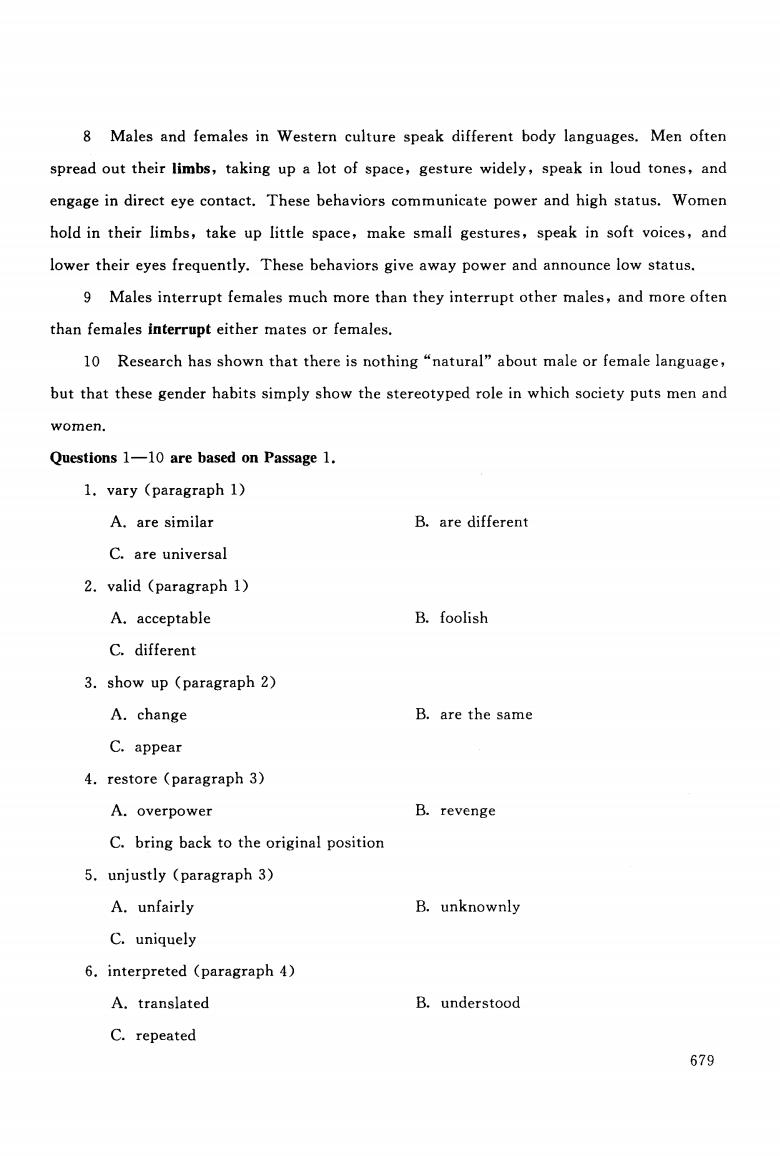
8 Males and females in Western culture speak different body languages.Men often spread out their limbs,taking up a lot of space,gesture widely,speak in loud tones,and engage in direct eye contact.These behaviors communicate power and high status.Women hold in their limbs,take up little space,make small gestures,speak in soft voices,and lower their eyes frequently.These behaviors give away power and announce low status. 9 Males interrupt females much more than they interrupt other males,and more often than females interrupt either mates or females. 10 Research has shown that there is nothing "natural"about male or female language, but that these gender habits simply show the stereotyped role in which society puts men and women. Questions 1-10 are based on Passage 1. 1.vary (paragraph 1) A.are similar B.are different C.are universal 2.valid (paragraph 1) A.acceptable B.foolish C.different 3.show up (paragraph 2) A.change B.are the same C.appear 4.restore (paragraph 3) A.overpower B.revenge C.bring back to the original position 5.unjustly (paragraph 3) A.unfairly B.unknownly C.uniquely 6.interpreted (paragraph 4) A.translated B.understood C.repeated 679
8 Males and females in Western culture speak different body languages. Men often spread out their Iimbs, taking up a lot of space , gesture widely , speak in loud tones, and engage in direct eye contact. These behaviors communicate power and high status. Women hold in their limbs, take up little space , make small gestures, speak in soft voices, and lower their eyes frequently. These behaviors give away power and announce low status. 9 Males interrupt females much more than they interrupt other males, and more often than females interrupt either mates or females. 10 Research has shown that there is nothing "natural" about mal or female language , but that these gender habits simply show the stereotyped role in which society puts men and women. Questions 1-10 are based on Passage 1. 1. vary (paragraph 1) A. are similar c. are universal 2. valid (paragraph 1) A. acceptable C. different 3. show up (paragraph 2) A. change C. appear 4. restore (paragraph 3) A. overpower C. bring back to the original position 5. unjust1y (paragraph 3) A. unfairly C. uniquely 6. interpreted (paragraph 4) A. translated C. repeated B. are different B. foolish B. are the same B. revenge B. unknownly B. understood 679
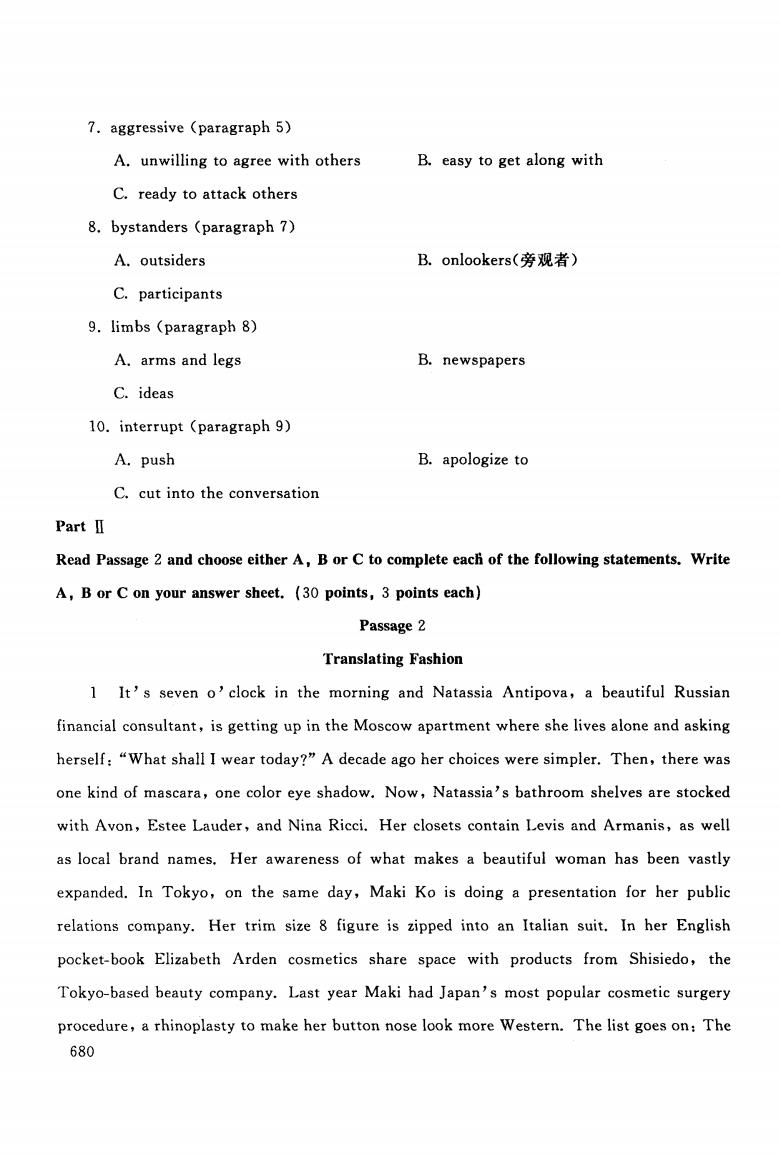
7.aggressive (paragraph 5) A.unwilling to agree with others B.easy to get along with C.ready to attack others 8.bystanders (paragraph 7) A.outsiders B.onlookers(旁观者) C.participants 9.limbs (paragraph 8) A.arms and legs B.newspapers C.ideas 10.interrupt (paragraph 9) A.push B.apologize to C.cut into the conversation PartⅡ Read Passage 2 and choose either A,B or C to complete each of the following statements.Write A,B or C on your answer sheet.(30 points,3 points each) Passage 2 Translating Fashion 1 It's seven o'clock in the morning and Natassia Antipova,a beautiful Russian financial consultant,is getting up in the Moscow apartment where she lives alone and asking herself:"What shall I wear today?"A decade ago her choices were simpler.Then,there was one kind of mascara,one color eye shadow.Now,Natassia's bathroom shelves are stocked with Avon,Estee Lauder,and Nina Ricci.Her closets contain Levis and Armanis,as well as local brand names.Her awareness of what makes a beautiful woman has been vastly expanded.In Tokyo,on the same day,Maki Ko is doing a presentation for her public relations company.Her trim size 8 figure is zipped into an Italian suit.In her English pocket-book Elizabeth Arden cosmetics share space with products from Shisiedo,the Tokyo-based beauty company.Last year Maki had Japan's most popular cosmetic surgery procedure,a rhinoplasty to make her button nose look more Western.The list goes on:The 680
7. aggressive (paragraph 5) A. unwilling to agree with others B. easy to get along with C. ready to attack others 8. bystanders (paragraph 7) A. outsiders B. onlookers( 旁观者) C. participants 9. limbs (paragraph 8) A. arms and legs B. newspapers C. ideas 10. interrupt (paragraph 9) A. push B. apologize to C. cut into the conversation Part II Read Passage 2 and choose either A , B or C to complete eacIi of the following statements. Write A , B or C on your answer sheet. (30 points, 3 points each) Passage 2 Translating Fashion 1 lt' s seven 0' clock in the morning and Natassia Antipova , a beautiful Russian financial consultant , is getting up in the Moscow apartment where she lives alone and asking herself: "What shall 1 wear today?" A decade ago her choices were simpler. Then , there was one kind of mascara , one color eye shadow. Now , Natassia' s bathroom shelves are stocked with Avon , Estee Lauder, and Nina Ricci. Her closets contain Levis and Armanis, as well as local brand names. Her awareness of what makes a beautiful woman has been vast\y expanded. In Tokyo , on the same day , Maki Ko is doing a presentation for her public relations company. Her trim size 8 figure is zipped into an ltalian suit. In her English pocket-book Elizabeth Arden cosmetics share space with products from Shisiedo , the Tokyo-based beauty company. Last year Maki had Japan' s most popular cosmetic surgery procedure , a rhinoplasty to make her button nose look more Western. The list goes on: The 680
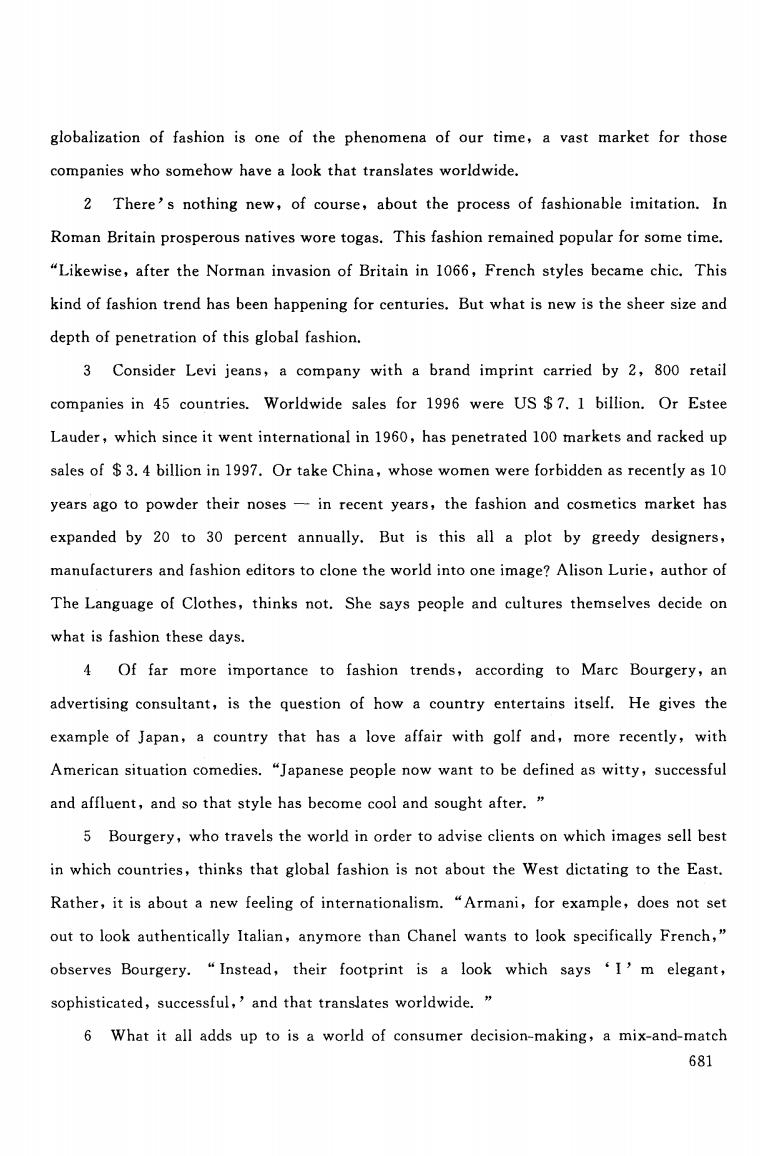
globalization of fashion is one of the phenomena of our time,a vast market for those companies who somehow have a look that translates worldwide. 2 There's nothing new,of course,about the process of fashionable imitation.In Roman Britain prosperous natives wore togas.This fashion remained popular for some time. "Likewise,after the Norman invasion of Britain in 1066,French styles became chic.This kind of fashion trend has been happening for centuries.But what is new is the sheer size and depth of penetration of this global fashion. 3 Consider Levi jeans,a company with a brand imprint carried by 2,800 retail companies in 45 countries.Worldwide sales for 1996 were US $7.I billion.Or Estee Lauder,which since it went international in 1960,has penetrated 100 markets and racked up sales of 3.4 billion in 1997.Or take China,whose women were forbidden as recently as 10 years ago to powder their noses-in recent years,the fashion and cosmetics market has expanded by 20 to 30 percent annually.But is this all a plot by greedy designers, manufacturers and fashion editors to clone the world into one image?Alison Lurie,author of The Language of Clothes,thinks not.She says people and cultures themselves decide on what is fashion these days. 4 Of far more importance to fashion trends,according to Marc Bourgery,an advertising consultant,is the question of how a country entertains itself.He gives the example of Japan,a country that has a love affair with golf and,more recently,with American situation comedies."Japanese people now want to be defined as witty,successful and affluent,and so that style has become cool and sought after. 5 Bourgery,who travels the world in order to advise clients on which images sell best in which countries,thinks that global fashion is not about the West dictating to the East. Rather,it is about a new feeling of internationalism."Armani,for example,does not set out to look authentically Italian,anymore than Chanel wants to look specifically French," observes Bourgery."Instead,their footprint is a look which says I'm elegant, sophisticated,successful,'and that translates worldwide. 6 What it all adds up to is a world of consumer decision-making,a mix-and-match 681
globalization of fashion is one of the phenomena of our time , a vast market for those companies who somehow have a look that translates worldwide. 2 There' s nothing new , of course , about the process of fashionable imitation. In Roman Britain prosperous natives wore togas. This fashion remained popular for some time. "Likewise , after the Norman invasion of Britain in 1066 , French styles became chic. This kind of fashion trend has been happening for centuries. But what is new is the sheer size and depth of penetration of this global fashion. 3 Consider Levi jeans, a company with a brand imprint carried by 2 , 800 retail companies in 45 countries. Worldwide sales for 1996 were US $ 7. 1 hillion. Or Estee Lauder , which since it went international in 1960 , has penetrated 100 markets and racked up sales of $ 3. 4 billion in 1997. Or take China , whose women were forbidden as recently as 10 years ago to powder their noses - in recent years, the fashion and cosmetics market has expanded by 20 to 30 percent annually. But is this all a plot by greedy designers, manufacturers and fashion editors to clone the world into one image? Alison Lurie , author of The Language of Clothes, thinks not. She says people and cultures themselves decide on what is fashion these days. 4 Of far more importance to fashion trends, according to Marc Bourgery , an advertising consultant , is the question of how a country entertains itself. He gives the example of J apan , a country that has a love aHair with golf and , more recently , with American situation comedies. "J apanese people now want to be defined as witty , successful and affluent , and so that style has become cool and sought after. " 5 Bourgery , who travels the world in order to advise clients on which images sell best in which countries, thinks that global fashion is not about the West dictating to the East. Rather, it is about a new feeling of internationalism. "Armani , for example , does not set out to look authentically ltalian , anymore than Chanel wants to look specifically French ," observes Bourgery. "Instead , their footprint is a look which says ‘ l' m elegant , sophisticated , successful , , and that translates worldwide. " 6 What it all adds up to is a world of consumer decision-making , a mix-and-match 681